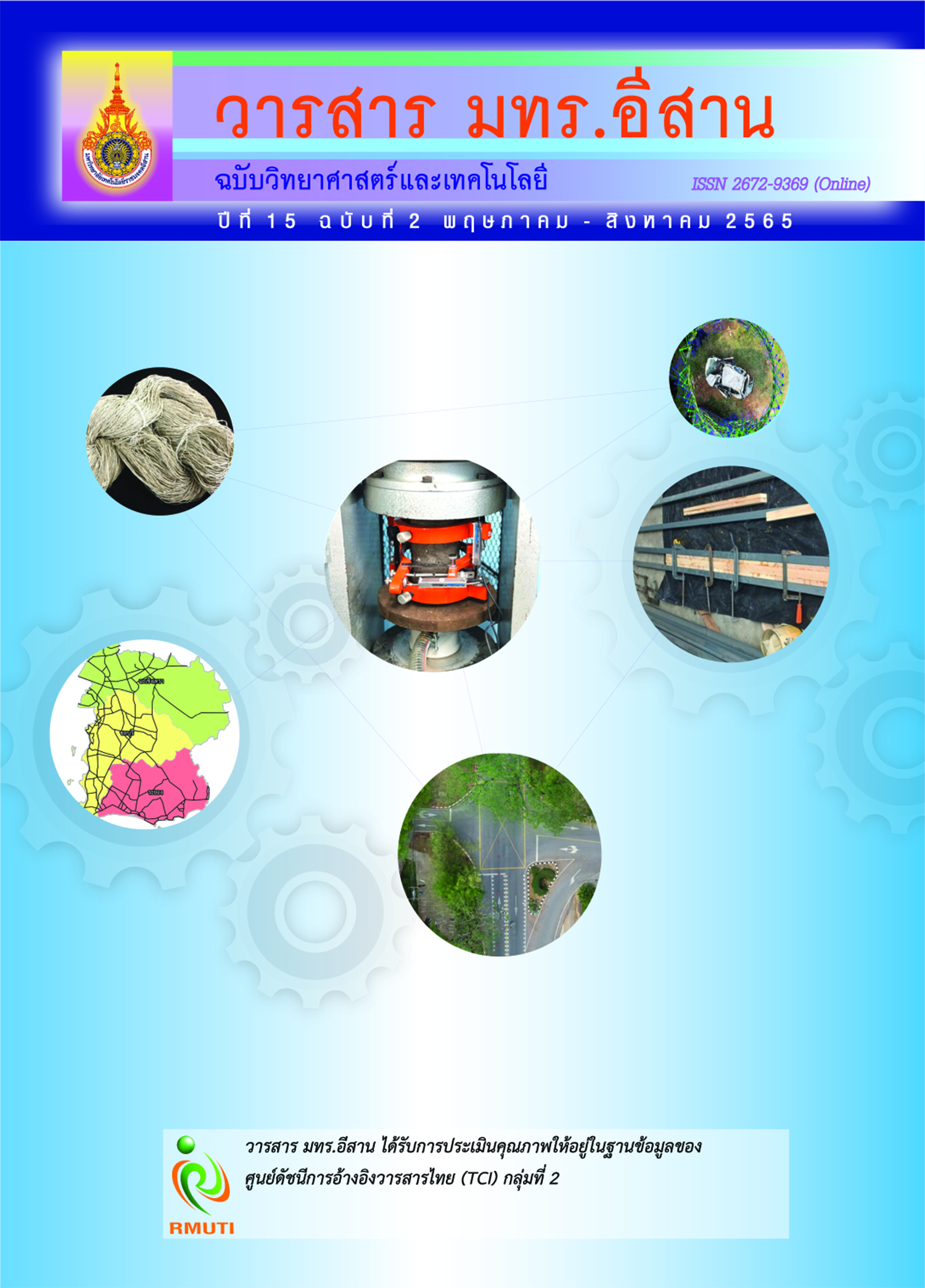Properties of Ply and Cord Yarns from Sacred Lotus Fibers (Nelumbo nucifera Gaertn.) Classified as Z on Z Twist
Main Article Content
Abstract
The objectives of this research were to study the physical properties of lotus ply yarns and cord yarns classified as Z on Z twist. The comparison of types of lotus stalk, the amounts of yarn affecting the yarn number, tenacity and elongation were studied. The experimental design used was factorial experiment in CRD. The preparation process of lotus fiber was done by stretching method from the milky latex inside the stalk of lotus using flower stalks and leaf stalks. The ply yarns spun in 2 and 3ply and the cord yarns spun in 2-2, 2-3, 3-2, and 3-3ply. The yarns were tested for physical properties according to ASTM. The results were as follows: the ply yarns had values of tenacity obtained ranged from 5.446-6.090 g/tex. The 2ply yarn of flower stalks had the highest tenacity. The yarn number obtained was 224.878-270.550 tex. The values of elongation obtained ranged from 3.351-4.182%. The 3ply yarn of leaf stalks had the highest the yarn number and elongation. The cord yarns had the yarn number obtained at 456.514-972.144 tex. The values of tenacity obtained ranged from 2.227-3.994 g/tex. The 3-3ply yarn of leaf stalks had the highest yarn number and tenacity. The values of elongation obtained were between 8.098-9.266%. The 2-3ply yarn of flower stalks had the highest elongation. Ply yarns revealed that the type of the lotus stalk significantly affected the yarn number at 0.05 level. The amount of yarn significantly affected yarn number and elongation at 0.01 level. Cord yarns showed that the type of the lotus stalk significantly affected yarn number at 0.01 level. The amount of yarn significantly affected yarn number, tenacity and elongation at 0.01 level.
Article Details

This work is licensed under a Creative Commons Attribution-NonCommercial-NoDerivatives 4.0 International License.
References
Karnjanakul, S. (2008). Lotus1. Bangkok: Setthasilp Printing
Suwannaro, T. (2016). Growing Lotus Ornament. Access (24 August 2021). Available (http://www.eto.ku.ac.th/neweto/e-book/plant/flower/nabua.pdf)
Chen, D. S., Gan, Y. J., and Yuan, X. H. (2012). Structure and Properties of Lotus Fibers. Advanced Materials Research. Vol. 476-478, No. 1, pp. 1948-1954. DOI: 10.4028/www.scientific.net/AMR.476-478.1948
Puthmee, T., Pougsombat, S., Tommol, W., and Janbang, N. (2015). Effects of Pulsing Solution and Stalks Length on Vase Life of 'Suttabhud' Lotus. In Proceeding of 14th National Horticultural Congress 2015. pp. 457-462
Gupta, N. (2020). The Spiritual Power of Lotus Fabric. IOSR Journal of Humanities and Social Science (IOSR-JHSS). Vol. 25, Issue 7, pp. 11-15
Punbua, N., Piromthamsiri, K., and Kraisuwan, S. (2018). Physical Properties of Sacred Lotus (Nelumbo nucifera Gaertn.) Spun Yarn: The Effects of Cultivars and Stem Parts. Thai Agriculture Research Journal. Vol. 36, No. 1, pp. 44-55. (in Thai)
Sachidhanandham, A. (2019). Sustainable Textiles From Lotus. Asian Textile Journal. Vol. 28, No. 10, pp. 56-59
Greenpeace. (2020). Greenpeace's City Rankings for PM2.5 in Thailand. Access (5 October 2021). Available (https://www.greenpeace.org/thailand/press/19362/world-airquality-repor-2020/)
United Nation. (2021). AR6 Climate Change 2021: The Physical Science Basis. Access (4 August 2021). Available (https://www.ipcc.ch/report/ar6/wg1/downloads/report/IPCC_AR6_WGI_Full_Report.pdf)
Ministry of Energy. (2015). Alternative Energy Development Plan (AEDP2015). Bangkok: Ministry of Energy
Department of Homeland Security. (2011). Classification of Fibers and Yarns Under the HTSUS. Access (12 June 2020). Available (https://www.cbp.gov/sites/default/files/assets/documents/2020-Feb/icp005r2_3.pdf)
Lord, P. R. (2003). Handbook of Yarn Production Technology, Science and Economics. Cambridge: Woodhead Publishing Ltd, and CRC Press LLC.
Chunchiyakarn, J., Chonsakorn, S., and Momgkholrattanasit, R. (2018). Physical Properties of Yok Denim Nakhon Fabric. RMUTI Journal Science and Tecnology. Vol. 11, No. 3, pp. 130-143. (in Thai)
Rungruangkitkrai, N. (2012). Lotus Weaving, Myanmar. Colourway. Vol. 18, Issue 101, pp. 46-48
Hattayananont, A., Soyraya, B., and Theeramongkol, P. (2013). Development of Textile in SLUB Yarn Fabric from Textile Material Waste. Faculty of Home Economics, Rajamangala University of Technology Phra Nakorn
Teeraprasert, S. (2014). Material Testing. Access (31 January 2021). Available (http://www.textiles.rmutk.ac.th/images/textiles_raw_material_control/textile_raw_material_control.pdf)
Phuphan, A., Rithnim, M., Sawanaoprn, S., and Maud-ew, C. (2009). The Exploration of the Separation of Fiber Method From Nelumbo Nucifera Gaertn (Lotus) Leaf Stalk and Examining the Development of Lotus Fiber into Thread. Access (27 May 2022). Available (http://www.research.rumutt/archives/5670)
Chonsakorn, S., Momgkholrattanasit, R., and Sriworadejpisan, S. (2017). The Development of Water Hyacinth Fiber to Creative Textile Products. Colourway. Vol. 21, No. 123, pp. 39-41
Patil, K. (2019). Lotus Fiber: A New Facet in Textile and Fashion. International Journal of Humanities and Social Science Invention (IJHSSI). Vol. 7, Issue. 12, pp. 71-75
Win, S. (2020). Study on Lotus Fiber Production in Sunn Ye Inn, Sintgaing Township. Banmaw University Research Journal. Vol. 11, No. 1, pp. 344-350


